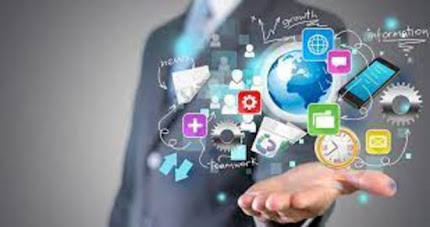The products of technology refer to the tangible and intangible outcomes resulting from the application of knowledge, tools, techniques, and resources to create solutions to various problems and meet human needs. These products can range from physical devices and equipment to software applications, services, and systems. In this article, I will explore the diverse array of technology products and their impact on different aspects of our lives.
1. Hardware Products:
a. Personal Computing Devices: Personal computers, laptops,
tablets, and smartphones are among the most common hardware products of
technology. These devices have revolutionized communication, information
access, and productivity for individuals worldwide.
b. Consumer Electronics: TVs, digital cameras, gaming
consoles, smartwatches, and other electronic gadgets are products that enhance
entertainment and leisure experiences.
c. Networking Equipment: Routers, switches, modems, and
network cables are vital components that enable connectivity and data exchange
in local and global networks.
d. Servers and Data Centers: These robust machines power the
internet and cloud computing services, storing and managing vast amounts of
data and providing various online services.
e. Robotics and Automation Systems: Robots and automated
machines are used in industries like manufacturing, healthcare, and logistics
to enhance efficiency and productivity.
f. 3D Printers: 3D printers produce three-dimensional
objects, enabling rapid prototyping and customization in various fields,
including manufacturing, healthcare, and aerospace.
2. Software Products:
a. Operating Systems: Windows, macOS, Linux, iOS, and
Android are examples of operating systems that manage computer hardware and
software resources and provide a user-friendly interface.
b. Applications: Productivity software (e.g., Microsoft
Office), creative tools (e.g., Adobe Suite), and specialized applications
(e.g., CAD software) cater to specific needs and industries.
c. Mobile Apps: Mobile applications cover a vast range of
functions, from social media and games to productivity tools and health-related
apps.
d. Web Applications: Web-based applications and online
services offer convenience and accessibility through internet browsers.
e. Games and Entertainment Software: Video games and
entertainment software provide immersive experiences and enjoyment for users.
f. Artificial Intelligence and Machine Learning Software: AI
and ML algorithms are used in various applications, including natural language
processing, computer vision, and recommendation systems.
3. Communication and Networking Products:
a. Internet Infrastructure: The internet itself is a product
of technology, connecting billions of devices and enabling global communication
and information exchange.
b. Telecommunication Devices: Smartphones, landline phones,
VoIP systems, and satellite communication devices facilitate voice and data
communication across vast distances.
c. Social Media Platforms: Platforms like Facebook, Twitter,
Instagram, and LinkedIn provide avenues for social networking and information
sharing.
d. Messaging Apps: WhatsApp, Telegram, WeChat, and others
offer instant messaging and communication services.
e. Video Conferencing Tools: Tools like Zoom, Microsoft
Teams, and Google Meet enable remote collaboration and virtual meetings.
4. Medical and Healthcare Products:
a. Medical Devices: Technologies such as MRI machines, CT
scanners, pacemakers, and insulin pumps improve diagnosis and treatment in
healthcare.
b. Telemedicine Solutions: Telehealth platforms and remote
monitoring devices facilitate virtual consultations and healthcare services.
c. Health and Fitness Apps: Mobile applications and wearable
devices monitor health metrics, track fitness activities, and provide
personalized health insights.
d. Pharmaceutical Products: Advancements in technology
contribute to the development of new drugs and therapies to combat diseases.
5. Transportation Products:
a. Electric Vehicles: Electric cars, bikes, and scooters are
eco-friendly alternatives to traditional fossil-fuel-powered vehicles.
b. Autonomous Vehicles: Self-driving cars and drones are
products of cutting-edge technology, promising to revolutionize transportation.
c. Navigation Systems: GPS devices and smartphone navigation
apps offer real-time directions and location-based services.
d. Transportation Management Systems: Software solutions
optimize logistics and fleet management, improving efficiency in
transportation.
6. Energy and Environmental Products:
a. Renewable Energy Technology: Solar panels, wind turbines,
and hydroelectric power systems harness renewable energy sources.
b. Energy Storage Solutions: Batteries and energy storage
technologies support the integration of renewable energy and grid stability.
c. Environmental Monitoring Devices: Sensors and systems
monitor air and water quality, helping to address environmental challenges.
d. Green Building Technology: Sustainable building materials
and energy-efficient systems reduce environmental impact in construction.
7. Financial and Banking Products:
a. Online Banking Platforms: Internet banking enables
customers to manage finances, make transactions, and access services remotely.
b. Digital Payment Solutions: Payment gateways, mobile
wallets, and contactless payment options simplify transactions.
c. Cryptocurrencies: Blockchain technology underpins
cryptocurrencies like Bitcoin, offering decentralized and secure digital
transactions.
d. FinTech Solutions: Financial technology innovations
include robo-advisors, peer-to-peer lending platforms, and crowdfunding
platforms.
8. Education and E-Learning Products:
a. Learning Management Systems: Online platforms facilitate
remote education, course management, and assessment.
b. E-Books and Digital Learning Materials: Digital content
provides easily accessible and interactive learning resources.
c. Educational Apps: Mobile applications offer interactive
learning experiences and gamified educational content.
d. Virtual Reality in Education: VR technology enhances
experiential learning and simulates real-world scenarios.
